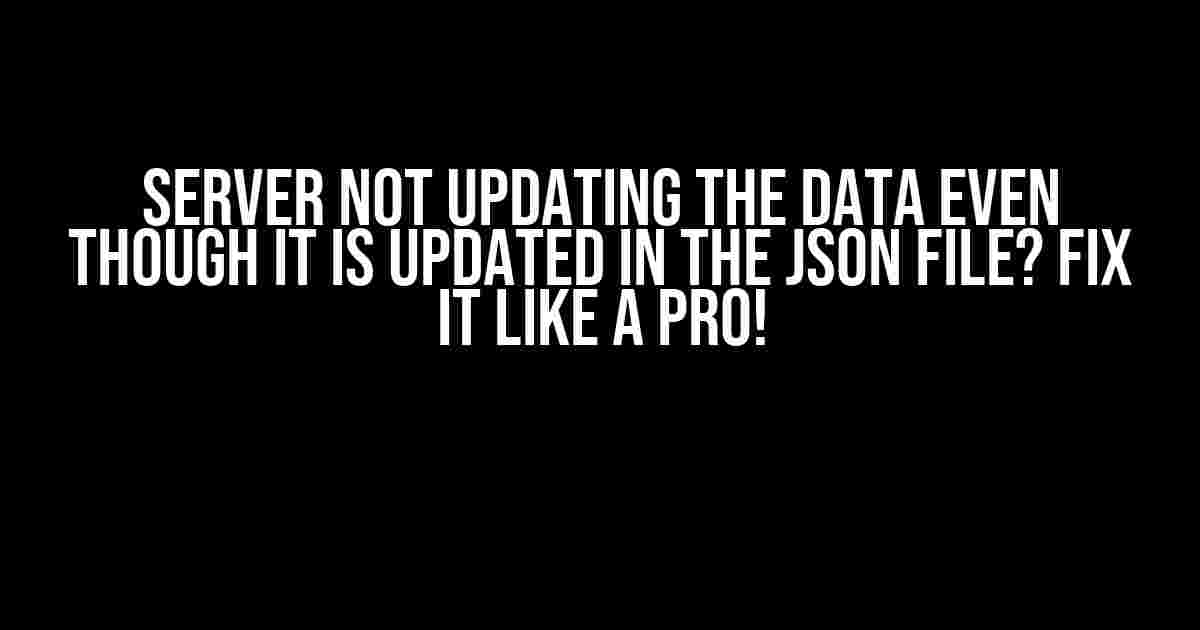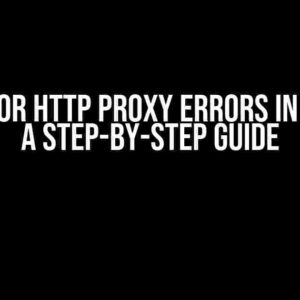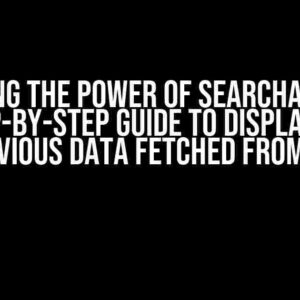Are you tired of staring at your server, scratching your head, and wondering why it’s not updating the data even though you’ve updated the JSON file? You’re not alone! This frustration is all too common, but fear not, dear developer, for we’re about to dive into the solutions to this pesky problem.
Understanding the Issue
Before we dive into the fixes, let’s take a step back and understand what’s happening. When you update a JSON file, your server should ideally reflect those changes. But sometimes, it just doesn’t. This can be due to various reasons, including:
- Caching issues
- Incorrect file paths or naming conventions
- Server-side rendering (SSR) quirks
- async/await mishaps
Cache-Busting: The Easiest Fix
One of the most common reasons for this issue is caching. Yes, caching! That wonderful feature that speeds up your website can sometimes get in the way of updating your data. To fix this, try one of the following cache-busting techniques:
-
Append a query parameter to your JSON file URL:
https://example.com/data.json?v=2The
?v=2part tells the browser to fetch a new version of the file, bypassing the cache. -
Use a cache-control header:
Cache-Control: no-cache, no-store, max-age=0, must-revalidateThis header tells the browser to never cache the JSON file and always fetch a fresh copy.
-
Implement cache-invalidation using ETag or Last-Modified headers:
ETag: "123456789" Last-Modified: Mon, 21 Jan 2023 01:23:45 GMTThese headers allow the browser to check if the file has changed since the last request, and if so, fetch a new copy.
File Paths and Naming Conventions: The Devil’s in the Details
Double-check that your file paths and naming conventions are correct. A single typo or mismatch can cause the server to ignore your updates. Ensure that:
-
Your JSON file is named correctly (e.g.,
data.json) and is located in the correct directory. -
Your server-side code is importing the correct file path and name.
-
Any server-side rendering (SSR) configurations are correctly set up to fetch the updated file.
Async/Await: The Timing Is Everything
Async/await is a powerful tool, but when not used correctly, it can lead to timing issues. Make sure that:
-
You’re using async/await correctly in your server-side code to handle promise resolutions.
-
Your code is waiting for the JSON file to be fully loaded before processing it.
-
You’re not accidentally overwriting the updated data with stale data.
Server-Side Rendering (SSR): The Gotcha
Server-side rendering (SSR) can sometimes cause issues with updated data. Try one of the following:
-
Disable SSR for the specific route or page that’s experiencing the issue.
-
Use a SSR-specific cache invalidation mechanism, such as using a unique cache key.
-
Implement a custom SSR caching strategy that takes into account the updated JSON file.
Other Culprits: Don’t Forget About These!
In addition to the above solutions, also consider the following potential culprits:
-
Browser extensions or add-ons interfering with your development environment.
-
Outdated dependencies or libraries that need to be updated.
-
Server configuration issues, such as incorrect file permissions or MIME types.
Conclusion
There you have it! With these solutions, you should be able to fix the issue of your server not updating the data even though it’s updated in the JSON file. Remember to stay vigilant, and don’t be afraid to experiment and try different approaches until you find the one that works for you.
| Solution | Description |
|---|---|
| Cache-Busting | Append a query parameter, use a cache-control header, or implement cache-invalidation using ETag or Last-Modified headers. |
| File Paths and Naming Conventions | Double-check file paths and naming conventions for correctness. |
| Async/Await | Use async/await correctly in server-side code to handle promise resolutions. |
| Server-Side Rendering (SSR) | Disable SSR, use a SSR-specific cache invalidation mechanism, or implement a custom SSR caching strategy. |
By following these guidelines, you’ll be well on your way to resolving the issue and ensuring that your server stays up-to-date with the latest data.
Frequently Asked Question
Are you scratching your head wondering why your server isn’t updating the data even though you’ve made changes to the JSON file? Well, you’re not alone! Here are some frequently asked questions and answers to help you troubleshoot this issue:
Q: Have I saved the JSON file correctly?
A: Make sure you’ve saved the JSON file in the correct location and with the correct file name. Double-check that the file is in the correct format (UTF-8) and that there are no syntax errors. A simple mistake can prevent the server from reading the file!
Q: Is the server configured to read the JSON file?
A: Verify that the server is configured to read the JSON file. Check the server settings, and ensure that the file path and name are correct. Also, check the server logs for any error messages that might indicate a configuration issue.
Q: Are there any caching issues?
A: Yeah, caching can be a real culprit! Clear the cache on both the server and client-side to ensure that the updated data is being retrieved. You can also try disabling caching temporarily to see if that resolves the issue.
Q: Is the data being updated in the correct location?
A: Make sure the data is being updated in the correct location, and that the server is looking in the right place for the updated data. Double-check the file structure and folder hierarchy to ensure everything is in its correct place!
Q: Are there any JavaScript or coding errors?
A: Ah, code can be finicky! Check your JavaScript code and the server-side code for any errors or typos. A single mistake can prevent the data from updating correctly. Use debugging tools to identify and fix any issues!





